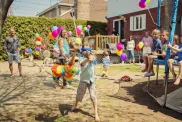Childhood depression can be a challenge to spot because children are unlikely to say, “Mom, I feel depressed.” They are, in fact, more likely to tell you they are sad or worried.
Children are more likely to show signs of anxiety, withdrawal, loss of interest in activities, loss of or significant increase in appetite, lethargy or worry. Persistent irritability and anger may also be signs of childhood depression.
As a parent you can help by noticing changes in your child’s every day behavior. Look for both cognitive and physical signs of depression. Does your child talk about how he or she feels helpless, isolated or unworthy? Does your child show changes in sleeping, eating and play patterns? Does your child try to shy away from activities or tell you they feel sick all the time.
Sad feelings often signal a child’s inability to meet the task demands that face them each day. So help your child to find the words to express their feelings. Kimochis is a doll that comes with a curriculum to explore feelings as well as a pocket full of feelings. Using Kimochis can provide you with a tool, as a parent, to aide your child is talking about how he or she feels.
If you notice a change in your child’s overall demeanor talk with your pediatrician help comes in many forms like social support, nutritional support, cognitive therapy and/or medication. Helping your child build skills to feel good and live with vitality is your goal as a parent. Addressing concerns early is key. Helpful books for you to review include: Lonely, sad and angry: How to help your unhappy child by Barbara D. Ingersoll PhD and Sam Goldstein PhD and My Feeling Better Workbook by Sara Hamil.








